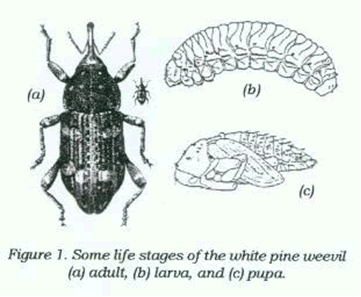Pissodes strobi (Peck)
The white pine weevil is probably the most serious pest of white pine in the area. The attacks of this insect stunt or distort trees and can kill two or three years of growth.
Life History
The adults are reddish-brown snout beetles about a quarter-inch long that are marked irregularly with patches of brown and white scales. Adults overwinter in litter on the ground and resume activity in April. The weevils prefer small trees, three to 15 feet in height in a sunny location; they seldom attack trees growing in the shade of other trees. They go to the terminal shoots and feed on bark tissue. The weevils then chew small pits in the leader and lay their eggs there in May. The eggs hatch in a week to 10 days and the legless, white grubs feed on the inner bark and tissues that produce tree growth. When several larvae are feeding, the shoot is soon girdled and dies. The grubs mature and pupate inside the leaders. Adult beetles emerge from late June to early September. Since spring egg laying lasts more than a month, one shoot can contain larvae in various stages of growth. There is only one generation a year. After emergence, the beetles spread to new areas by flight.

Damage
The first sign of attack ranges from small, glistening droplets to resin oozing from tiny holes in the leader, especially near the terminal bud. This is caused by adult weevils that are feeding before egg-laying. As the feeding grubs girdle the terminal, the new shoot of the current year's growth withers, the tip bends over and turns brown. This is usually noticeable about mid-June. Examination of the dead shoots will show the white larvae or pupae beneath the bark or in the wood and pitch. The year's growth is always killed, but up to five year's growth is commonly killed. The result is forked and crooked trees.
Host Trees
Most seriously attacked:
- white pine
- Norway spruce
- jack pine
Commonly attacked:
- pitch pine
- Japanese red pine
- western white pine
- limber pine
- foxtail pine
- red spruce
Occasionally attacked:
- Scotch pine
- western yellow pine
- mugo pine
- blue spruce
- white spruce
Rarely attacked:
- red or Norway pine
- Himalayan blue pine
- Douglas fir
Control
Cut and burn weevilled leaders from the time the leader begins to wilt until the first half of July to kill the weevils inside. If the infected branch is not removed and destroyed the weevils can survive and spread. One or more of the lateral branches will take over and grow as the new terminal shoot
Despite good cultural practices, pests and diseases at times may appear. Chemical control should be used only after all other methods have failed.
For pesticide information or other questions please call toll free: 877-486-6271.
Revised by the UConn Home & Garden Education Center, 2016.